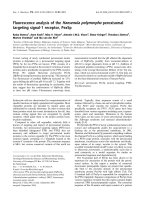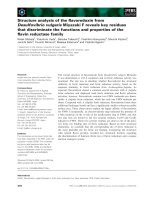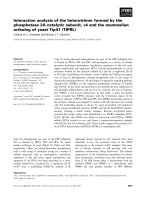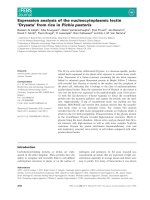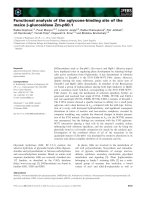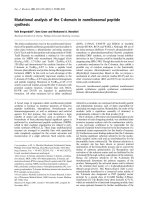Báo cáo hóa học: "Performance Analysis of the Blind Minimum Output Variance Estimator for Carrier Frequency Offset in " pot
Bạn đang xem bản rút gọn của tài liệu. Xem và tải ngay bản đầy đủ của tài liệu tại đây (1022.6 KB, 8 trang )
Hindawi Publishing Corporation
EURASIP Journal on Applied Signal Processing
Volume 2006, Article ID 49257, Pages 1–8
DOI 10.1155/ASP/2006/49257
Performance Analysis of the Blind Minimum
Output Variance Estimator for Carrier Frequency
Offset in OFDM Systems
Feng Yang, Kwok H. Li, and Kah C. Teh
School of Elect rical and Electronic Engineering, Nanyang Technological University, Singapore 639798, Singapore
Received 18 November 2004; Revised 13 July 2005; Accepted 29 December 2005
Recommended for Publication by Alexei Gorokhov
Carrier frequency offset (CFO) is a serious drawback in orthogonal frequency division multiplexing (OFDM) systems. It must
be estimated and compensated before demodulation to guarantee the system performance. In this paper, we examine the perfor-
mance of a blind minimum output variance (MOV) estimator. Based on the derived probability density function (PDF) of the
output magnitude, its mean and variance are obtained and it is observed that the variance reaches the minimum when there is
no frequency offset. This observation motivates the development of the proposed MOV estimator. The theoretical mean-square
error (MSE) of the MOV estimator over an AWGN channel is obtained. The analytical results are in good agreement with the
simulation results. The performance evaluation of the MOV estimator is extended to a frequency-selective fading channel and the
maximal-ratio combining (MRC) technique is applied to enhance the MOV estimator’s performance. Simulation results show that
the MRC technique significantly improves the accuracy of the MOV estimator.
Copyright © 2006 Hindawi Publishing Corp oration. All rights reserved.
1. INTRODUCTION
Orthogonal frequency division multiplexing (OFDM) has
been considered as a promising modulation scheme for the
next generation wireless communication systems. OFDM
signals are transmitted in parallel subchannels, which are
frequency-nonselective and overlapped in spectr a. Hence,
OFDM systems are robust to frequency-selective fading and
enjoy high bandwidth efficiency. As the symbol duration is
extended, the OFDM scheme reduces the normalized de-
lay spread and avoids intersymbol interference (ISI). Be-
cause of these excellent characteristics, OFDM has been sug-
gested and standardized for high-speed communications in
Europe for digital audio broadcasting (DAB) [1]andter-
restrial digital video broadcasting (DVB) [2]. Furthermore,
OFDM is standardized for broadband wireless local area
networks, for example, ETSI-BRAN High-performance lo-
cal area networks (Hiperlan/2) [3], IEEE 802.11a [4], and
for broadband wireless access, for example, IEEE 802.16 [5].
One drawback of OFDM systems is that carrier frequency
offset (CFO) between the transmitter and receiver may de-
grade system performance severely [6]. CFO causes a num-
ber of impairments, including the attenuation a nd phase ro-
tation of each of the subcarriers and intercarrier interference
(ICI). Many estimation techniques have b een proposed to
estimate and correct the CFO before demodulation. Moose
proposed a scheme to estimate CFO by repeating a data
symbol and comparing the phase of each of the subcarri-
ers between successive symbols [7]. However, this scheme
adds more overhead and reduces the bandwidth efficiency.
Schmidl and Cox proposed an estimation algorithm for tim-
ing offset and carrier frequency offset estimation based on
the training sequence [8]. To improve the bandwidth effi-
ciency, many blind estimation techniques have been pro-
posed. van de Beek et al. developed a maximum-likelihood
(ML) estimator by exploiting the redundancy in the cyclic
prefix (CP) [9]. This method, however, suffers from perfor-
mance degradation when the delay spread is comparable to
the length of CP. Luise et al. exploited the time-frequency
domain exchange inherent to the modulation scheme and
proposed a blind algorithm for CFO recovery [10]. Tureli
et al. utilized the shift invariant feature of the signal struc-
ture and extended ESPRIT algorithm to estimate CFO [11].
Tureli et al. exploited the inherent orthogonality between
information-bearing carriers and virtual carriers, and pro-
posed an algorithm to estimate the CFO [12]. Because of the
presence of the virtual carriers for the proposed algorithms
in [11, 12], the bandwidth efficiency is also reduced. In our
2 EURASIP Journal on Applied Signal Processing
previous work [13], we proposed a new blind estimation al-
gorithm which yields high bandwidth efficiency and high
accuracy based on the minimum output variance (MOV).
In [13], the per formance of the MOV estimator is obtained
by simulations. The main objective of this paper is to de-
rive the theoretical mean and variance of the MOV estima-
tor and examine the performance analytically. We also eval-
uate the performance of the MOV estimator over frequency-
selective fading channels and apply the maximal-ratio com-
bining (MRC) technique to improve its per formance.
The rest of the paper is organized as follows. In Section 2,
the OFDM system model is briefly introduced. In Section 3,
the MOV estimator is described and its performance is an-
alyzed over additive white Gaussian noise (AWGN) chan-
nels. Numerical results are presented in both AWGN and
frequency-selective fading channels in Section 4. F inally,
conclusions are drawn in Section 5 .
2. OFDM SYSTEMS
OFDM is a form of mutlicarrier modulation and consists
of a number of narrowband orthogonal subcarriers trans-
mitted in a synchronous manner. The mth OFDM data
blocktobetransmittedcanbedefinedass(m)
= [s
0
(m),
s
1
(m), , s
N−1
(m)]
T
,whereN is the number of subcarri-
ers. The OFDM signals can b e formulated by inverse discrete
Fourier transform (IDFT). Using the matrix representation,
the mth block of the modulated signal is
x(m)
=
x
0
(m), x
1
(m), , x
N−1
(m)
T
= Ws(m), (1)
where W is the IDFT matrix given by
W
=
1
√
N
⎡
⎢
⎢
⎢
⎢
⎣
11··· 1
1 e
jω
··· e
j(N−1)ω
.
.
.
.
.
.
.
.
.
.
.
.
1 e
j(N−1)ω
··· e
j(N−1)×(N−1)ω
⎤
⎥
⎥
⎥
⎥
⎦
N×N
(2)
with ω
= 2π/N. After the IDFT modulation, a cyclic prefix
(CP) is inserted and its length is assumed to be longer than
the maximum delay spread of the channel to avoid intersym-
bol interference (ISI). The resultant baseband signal is up-
converted to the radio frequency (RF) and transmitted over a
multipath fading channel. At the receiver, the signal is down-
converted and demodulated using discrete Fourier transform
(DFT) to recover the desired signal. In the absence of CFO,
the received signal is given by
y(m)
= WHs(m)+n(m), (3)
where
H
= diag
H
0
(m), H
1
(m), , H
N−1
(m)
(4)
represents the channel response in the frequency domain. Af-
ter down-conversion, the carrier frequency offset Δ f is in-
curred because of the mismatch of carrier frequencies be-
tween the transmitter and receiver. The received signal, after
the removal of the CP, is
y(m)
= ΦWHs(m)+n(m), (5)
where
Φ
= diag
1, e
jφ
0
, , e
j(N−1)φ
0
(6)
denotes the CFO matrix. Note that φ
0
= 2πΔ fT
s
/N and T
s
is the OFDM block duration.
3. ESTIMATION OF CARRIER FREQUENCY OFFSET
Due to spectra overlapping, OFDM systems are sensitive to
CFO. The CFO destroys the orthogonality among subcarri-
ers, results in intercarrier interference (ICI) and causes sys-
tem performance degradation. To improve the system per-
formance, the CFO must be estimated and compensated be-
fore the DFT demodulation.
3.1. Minimum output variance (MOV) estimator
In the presence of CFO, the received signal, after DFT de-
modulation, is given by
d(m)
= W
H
y(m) = W
H
ΦWHs(m)+n
(m), (7)
where W
H
represents the DFT demodulation matrix, d(m) =
[d
0
(m), d
1
(m), , d
N−1
(m)]
T
is the recovered signal vector
and n
(m) is the noise term after the DFT operation. Because
of the presence of CFO, W
H
ΦW is no longer an identity ma-
trix and the desired signal s(m) cannot be recovered properly.
For the sake of simplicity, the block number m will not be in-
cluded in the subsequent derivation. The recovered signal on
subcarrier k is given by
d
k
= I
0
s
k
+
N−1
l=0,l=k
I
l−k
s
l
,(8)
where
I
n
=
sin
πΔ fT
s
N sin
(π/N)
Δ fT
s
+ n
·
exp
j
π
N
(N − 1)Δ fT
s
− n
.
(9)
In (8), I
0
represents the attenuation and phase rotation of
the desired signal and I
l−k
represents the ICI coefficient from
other subcarriers. From (8)and(9), it can be seen that the
coefficient I
0
of s
k
is independent of k. It implies that the de-
sired signals on all subcarriers experience the same degree
of attenuation and phase rotation. Note that the ICI term
is the addition of many independent random variables and
can be approximated as a complex Gaussian random variable
with zero mean [15, 16]. Thus, the output of each subcarrier
can be considered as a dominant signal embedded in addi-
tive white Gaussian noise. To simplify the analysis, the BPSK
modulation is employed in the OFDM scheme.
The ICI power is defined as
P
ICI
E
N−1
l=0,l=k
I
l−k
s
l
2
(10)
Feng Yang et al. 3
00.05 0.10.15 0.20.25 0.30.35 0.40.45 0.5
ε
= Δ fT
s
−60
−50
−40
−30
−20
−10
0
P
ICI
(dB)
Exact calculation of ICI power
Simulation of ICI power
Figure 1: The theoretical and the simulation results of the ICI
power.
and P
ICI
can be obtained as [17]
P
ICI
=
1
−1
1 −|x|
1 − e
j2πx
dx
= 1 −sinc
2
(),
(11)
where
= Δ fT
s
∈ (−0.5, 0.5) is the CFO normalized to the
subcarrier spacing and sinc(x)
= sin (πx)/(πx). The theoret-
ical and the simulation results of the ICI power are presented
in Figure 1. It is observed that the theoretical cur ve based on
(11) matches the simulation results well.
Since the ICI can be approximated as a Gaussian random
variable with zero mean, the variance of the ICI is equal to
σ
2
= P
ICI
= 1 −sinc
2
() . (12)
From (8)and(9), it is clear that the dominant signal on
the kth subcarrier is I
0
s
k
. Hence, the magnitude mean of the
dominant signal on the kth subcarrier is
m
=
I
0
s
k
=
sin π
π
e
jπ
s
k
=
sinc(). (13)
Based on the analysis above, the probability density function
(PDF) of the output
|d
k
| can be approximated as Gaussian
mixture given by
p
|d
k
|
(x) =
1
√
2πσ
e
−(x−m)
2
/2σ
2
+
1
√
2πσ
e
−(x+m)
2
/2σ
2
u(x),
(14)
where u(x) is the unit step function. Let us consider the ex-
pectation and variance of the output
|d
k
|. The expectation of
|d
k
| is
E
d
k
=
∞
−∞
xp
|d
k
|
(x)dx
=
2
1 − sinc
2
()
π
exp
−
sinc
2
()
2
1 − sinc
2
()
+ sinc() −2 sinc()Q
⎛
⎝
sinc()
1 − sinc
2
()
⎞
⎠
,
(15)
where
Q(x)
=
1
√
2π
∞
x
e
−t
2
/2
dt. (16)
The second moment of
|d
k
| is
E
d
k
2
=
∞
−∞
x
2
p
|d
k
|
(x)dx
= m
2
+ σ
2
−
m
2
+ σ
2
− 1
Q
m
σ
=
1.
(17)
The variance of
|d
k
| can be expressed as
var
d
k
=
E
d
k
2
−
E
2
d
k
. (18)
From (15), (17), and (18), it is observed that the expec-
tation and variance of
|d
k
| are functions of . Figures 2(a),
2(b),and2(c) show the expectation, the variance, and the
second moment of
|d
k
| versus the normalized CFO, respec-
tively. From these figures, it is observed that the simulation
results match the theoretical results well. The results also
show that the variance of
|d
k
| monotonically increases and
the expectation of
|d
k
| monotonically decreases when the
normalized CFO
|| increases. In other words, the minimum
variance and maximum mean are obtained when
= 0. In-
tuitively, this property can be explained as follows. The CFO
does not change the total signal power in one received sym-
bol [14], but the CFO causes the uncertainty of the output.
More frequency offset causes more uncertainties and thus,
the variance of the output
|d
k
| increases. This is the principal
idea for the CFO estimator proposed in [13].
Based on this property, we have proposed a blind CFO
estimator with minimum output variance (MOV) for OFDM
systems in [13]. When N is sufficiently large, the expectation
of
|d
k
| is approximately equal to the average value of |d
k
|
among N subcarriers. From the previous analysis, the average
value of
|d
k
| attains a maximum value if the CFO is properly
compensated. Defining
Φ
e
= diag
1, e
jφ
e
, , e
j(N−1)φ
e
, (19)
we search for φ
e
in the range of (−π/N, π/N) such that
Λ
φ
e
1
N
N
i=1
W
H
i
Φ
H
e
ΦWHs(m)
(20)
4 EURASIP Journal on Applied Signal Processing
−0.5 −0.4 −0.3 −0.2 −0.10 0.10.20.30.40.5
Δ fT
s
0.8
0.85
0.9
0.95
1
E(|d
k
|)
Simulation result
Theoretical result
(a)
−0.5 −0.4 −0.3 −0.2 −0.10 0.10.20.30.40.5
Δ fT
s
0
0.1
0.2
0.3
0.4
var(|d
k
|)
Simulation result
Theoretical result
(b)
−0.5 −0.4 −0.3 −0.2 −0.10 0.10.20.30.40.5
Δ fT
s
0.8
0.9
1
1.1
E(|d
k
|
2
)
Simulation result
Theoretical result
(c)
Figure 2: (a) Expectation of |d
k
|versus ,(b)varianceof|d
k
|versus
, (c) second moment of |d
k
| versus .
achieves its maximum value for Φ
e
= Φ,whereW
i
is the ith
column of the matrix W. If thermal noise is present, the ac-
curacy of φ
e
may be improved by searching for the maximal
value in (20) with more blocks. Hence, the proposed MOV
estimatoristosearchforoneφ
e
to maximize Λ(φ
e
)[13], that
is,
φ
e
= arg max
φ
e
1
MN
M
m=1
N
i=1
W
H
i
Φ
H
e
y(m)
, (21)
where y(m)isdefinedin(5)andM is the number of blocks
used by the MOV estimator. Based on (21), the DFT oper a-
tion W
H
i
in MOV estimator can be implemented efficiently
by means of the fast Fourier transform (FFT) algorithm. Al-
though the above analysis is based on BPSK modulation, it is
also applicable to higher-order modulation schemes such as
QPSK, 8-QAM, 16-QAM, and 64-QAM, and so forth. Simu-
lations have been conducted to verify that the MOV estima-
tor is applicable to higher-order modulation methods.
3.2. Performance analysis of the MOV estimator
For the MOV estimator, we need to obtain the expected value
of
|d
k
|for each trial value of φ
e
. The expectation of |d
k
|is ap-
proximated by the average value of
|d
k
| among MN outputs,
that is,
E
d
k
=
μ
φ
e
≈ μ
φ
e
=
1/MN
M
m=1
N
i=1
W
H
i
Φ
H
e
y(m)
.
(22)
When
|d
k
| is embedded in AWGN, the accuracy of this ap-
proximation is affected and the difference between the ex-
pected value and the approximated average value is the ma-
jor contribution to the error variance of the MOV estimator.
It is known that
μ
φ
e
follows the Gaussian distribution with
mean μ
φ
e
and variance σ
2
w
/MN [18], where σ
2
w
represents the
variance of AWGN noise. Thus, it has a probability that
μ
φ
e
(for φ
e
= φ
0
) is greater than the theoretical maximum mean
value
μ
φ
0
. When this happens, the estimation accuracy is af-
fected. Equivalently, the analysis can be addressed as follows.
Suppose that we have K trial values of φ
e
among the estima-
tion range and we obtain the average output for each trial
value independently. For the kth trial value, the average out-
put is
μ
k
= μ
k
+n
k
,wheren
k
denotes the noise term with zero
mean and variance σ
2
w
/MN. The probability that μ
k
becomes
the largest can be expressed as
Pr
μ
k
= max
μ
1
, , μ
K
= Pr
μ
k
> μ
1
, μ
k
> μ
2
, , μ
k
> μ
K
=
Pr
μ
k
+ n
k
>μ
1
+ n
1
, , μ
k
+ n
k
>μ
K
+ n
K
.
(23)
Note that n
1
, n
2
, , n
K
are independent noise. For a given
n
k
, the conditional probability can be expressed as
Pr
μ
k
= max
μ
1
, , μ
K
| n
k
= Pr
n
1
<μ
k
− μ
1
+ n
k
, , n
K
<μ
k
− μ
K
+ n
k
= Pr
n
1
<μ
k
− μ
1
+ n
k
×···×Pr
n
K
<μ
k
− μ
K
+ n
k
=
⎛
⎝
1 − Q
⎛
⎝
μ
k
− μ
1
+ n
k
2σ
2
w
/MN
⎞
⎠
⎞
⎠
×···×
⎛
⎝
1 − Q
⎛
⎝
μ
k
− μ
K
+ n
k
2σ
2
w
/MN
⎞
⎠
⎞
⎠
.
(24)
Thus, the probability that
μ
k
becomes the largest is obtained
as
Pr
μ
k
= max
μ
1
, , μ
K
=
∞
−∞
Pr
μ
k
| n
k
p
n
k
(x)dx, k = 1, 2, , K,
(25)
where p
n
k
(x) denotes the Gaussian PDF of n
k
given by
p
n
k
(x) =
1
2πσ
2
w
/MN
exp
−
x
2
2σ
2
w
/MN
. (26)
Feng Yang et al. 5
0 5 10 15 20 25 30
E
b
/N
0
(dB)
10
−7
10
−6
10
−5
10
−4
10
−3
10
−2
10
−1
Normalized MSE
T&H, 4 blocks
MOV, 1 block
MOV, 2 blocks
MOV, 3 blocks
MOV, 4 blocks
Theoretical results
Figure 3: Normalized MSE of the proposed MOV estimator versus
E
b
/N
0
with various number of OFDM blocks over AWGN channels.
When all the K probabilities in (25) are obtained, the
mean and variance of the estimated offset can be obtained
accordingly. Here, the variance represents the mean-square
error (MSE) of the MOV estimator. The MSE results will be
validated in the next sect ion.
4. NUMERICAL RESULTS AND ANALYSIS
In this section, numerical results are presented to illustrate
the performance of the proposed MOV estimator in OFDM
systems. In par ticular, N
= 64 subcarriers are used. The per-
formance of the proposed MOV estimator is examined by the
normalized MSE defined as
MSE
= E
φ
e
− φ
0
2
(2π/N)
2
≈
1
P
P
p=1
φ
e
p
− φ
0
2
(2π/N)
2
, (27)
where
φ
e
is the estimate of φ
0
and P is the number of Monte
Carlo runs. Simulations are conducted in both AWGN and
frequency-selective fading channels.
4.1. Performance over AWGN channels
Figure 3 shows the normalized MSE of the proposed MOV
estimator over an AWGN channel. From the simulation re-
sults, it is observed that the normalized MSE decreases as
E
b
/N
0
increases. With more OFDM blocks, the accuracy of
the proposed MOV estimator is in general improved. The ap-
proximated MSE values are the corresponding solid lines in
Figure 3. The simulation results match the theoretical results
well at high E
b
/N
0
, that is, E
b
/N
0
> 10 dB. The p erformance
curve of the T&H estimator [12] is also included for compar-
ison, where the number of subcarriers is N
= 64, the number
12 4 6 8 10 12 14 16 18 20
Number of blocks, M
10
−7
10
−6
10
−5
10
−4
10
−3
Normalized MSE
E
b
/N
0
= 10 dB
E
b
/N
0
= 15 dB
E
b
/N
0
= 20 dB
E
b
/N
0
= 25 dB
E
b
/N
0
= 30 dB
Theoretical results
Figure 4: Normalized MSE of the proposed MOV estimator versus
number of blocks over AWGN channels.
of virtual carriers is L = 20, and the number of blocks for
estimation is M
= 4. For the value of MSE = 10
−3
, the pro-
posed MOV algorithm outperforms the T&H algorithm by
more than 6 dB in E
b
/N
0
. The reason for the significant im-
provement is that the proposed MOV estimator takes the av-
erage of the magnitude output and is robust to noise, but
the orthogonality property utilized by the T&H estimator is
more sensitive to noise. Also, the proposed MOV algorithm
can be implemented by fast Fourier transform (FFT) with
high efficiency. Thus, the computational complexity of MOV
algorithm is generally lower than that of the T&H algorithm.
In Figure 4, we present the MSE results of the proposed
MOV algorithm with various numbers of OFDM blocks.
From the simulation results, it is observed that the normal-
ized MSE decreases with more OFDM blocks for estimation
but using more blocks for estimation increases the complex-
ity of the estimator. Also, the theoretical MSE results match
the simulation MSE results well. Note that the normalized
MSE is less than 10
−3
for moderately high E
b
/N
0
,which
makes the degradation caused by the CFO negligible even
when only one OFDM block is used for the estimation. Thus,
the proposed MOV estimator is also suitable for burst trans-
mission.
4.2. Performance over frequency-selective
fading channels
Over frequency-selective fading channels, a 6-path multipath
delay profile is assumed. The length of cyclic prefix (CP) is 6
and the maximal delay is not greater than the length of CP to
avoid ISI. The MOV estimator takes the average of the output
and searches for the maximum mean output. Thus, it is also
applicable for frequency-selective fading channels even when
6 EURASIP Journal on Applied Signal Processing
0 5 10 15 20 25 30
E
b
/N
0
(dB)
10
−5
10
−4
10
−3
10
−2
10
−1
Normalized MSE
1block
2blocks
3blocks
4blocks
Figure 5: Normalized MSE of the proposed MOV estimator ver-
sus E
b
/N
0
with various number of OFDM blocks over frequency-
selective fading channels.
the channel infor mation is not available. Figure 5 shows
the normalized MSE results over frequency-selective fading
channels. From the results, it is observed that the normalized
MSE is less than 4
×10
−3
when E
b
/N
0
≥10 dB. The error floor
is caused by the channel dispersion. It shows that the algo-
rithm achieves high accuracy with only a few OFDM blocks
under moderately high E
b
/N
0
. Thus, the proposed MOV al-
gorithm is effective and reliable over frequency-selective fad-
ing channels.
In Figure 6, the normalized MSE of the proposed MOV
algorithm is presented with different number of blocks over
frequency-selective fading channels. It is observed that the
accuracy is generally improved as the number of blocks
increases but the improvement becomes insignificant for
large M. Considering the system performance requirement
and complexity, the number of estimation blocks M should
be properly chosen.
4.3. Performance improvement with MRC technique
The MOV estimator takes the summation of the output
over the N subcarriers. It is similar to the combining tech-
niques in multicarrier CDMA (MC-CDMA) [19]. In MC-
CDMA systems, many diversity-combining techniques have
been applied to improve the system performance, for exam-
ple, equal-gain combining (EGC) and maximal-ratio com-
bining (MRC). With the MRC technique, the output SNR
is maximized [16, 21]. It is interesting to see whether the
MRC technique can improve the performance of the pro-
posed MOV estimator over frequency-selective fading chan-
nels.
In this subsection, we assume that the channel estimation
has been achieved and the channel attenuation and the phase
1 2 4 6 8 10 12 14 16 18 20
Number of blocks, M
10
−5
10
−4
10
−3
10
−2
Normalized MSE
E
b
/N
0
= 10 dB
E
b
/N
0
= 15 dB
E
b
/N
0
= 20 dB
Figure 6: Normalized MSE of the proposed MOV estimator versus
number of blocks over frequency-selective fading channels.
shift on each subcarrier are known to the MOV estimator.
Thus, the gain matrix for the MRC is given by [19, 20]
G
= diag
H
∗
0
, , H
∗
N−1
, (28)
where H
n
is the channel gain on the nth subcarrier in (4)and
the superscript (
·)
∗
denotes the complex conjugation. Mul-
tiplying with the gain matr ix G, the strong signals on subcar-
riers car ry larger weights than weak signals. Thus, the SNR of
the output is maximized and the performance of MOV esti-
mator is improved.
According to the channel gain with MRC, the MOV esti-
mator can be rewritten as
φ
e
= arg max
φ
e
Λ
φ
e
=
arg max
φ
e
1
MN
M
m=1
N
i=1
W
H
i
Φ
H
e
Gy(m)
,
(29)
where G represents the gain matrix for MRC.
The normalized MSE results of the proposed MOV es-
timator versus E
b
/N
0
with MRC technique over frequency-
selective fading channels are presented in Figure 7. From the
simulation results, it is observed that the normalized MSE
significantly decreases with MRC and the performance of the
proposedMOVestimatorwithMRCisevencomparableto
that of the MOV e stimator under the AWGN condition. It is
also clear that the error floor is eliminated. This supports the
argument that the error floor in Figure 6 is caused by chan-
nel dispersion. We also include the performance curve of the
T&H estimator [12] for comparison. It is seen that the pro-
posed MOV estimator still outperforms the T&H estimator
over the same fading channel conditions.
Feng Yang et al. 7
0 5 10 15 20 25 30 35 40
E
b
/N
0
(dB)
10
−7
10
−6
10
−5
10
−4
10
−3
10
−2
10
−1
Normalized MSE
T&H, 4 blocks
MOV, 1 block (with MRC)
MOV, 2 blocks (with MRC)
MOV, 3 blocks (with MRC)
MOV, 4 blocks (with MRC)
Figure 7: Normalized MSE of the proposed MOV estimator versus
E
b
/N
0
with MRC technique over frequency-selective fading chan-
nels.
4.4. Compensation of the CFO
After the CFO estimation is accomplished, frequency offset
can be properly compensated and corrected to allow for
the data detection. Figure 8 shows the BER performance
for three cases, namely, with 20% frequency offset, without
frequency offset, and after offset c orrection o ver frequency-
selective fading channels, respectively. It is observed that the
BER has an er ror fl oor when there is a 20% frequency offset.
The reason for the error floor is that the bit errors are mainly
due to the ICI, not due to the noise for high E
b
/N
0
.The
BER, after MOV estimation and correction, is very close to
the BER without CFO, which validates that MOV estimator
eliminates the effect of CFO effectively.
5. CONCLUSION
In this paper, we have examined the performance of the min-
imum output variance (MOV) estimator in OFDM systems.
The variance and the expectation of the output magnitude
have been derived for the MOV estimator. The theoretical
MSE of the MOV estimator has been derived and the theoret-
ical MSE results match the simulation results well. From the
simulation results, it is observed that the MOV algorithm has
high accuracy in both AWGN and frequency-selective fading
channels. It has also been shown that the MOV algorithm
outperforms the T&H algorithm. The MOV estimator can be
implemented by FFT efficiently, which causes the computa-
tional complexity of the MOV estimator generally lower than
that of the T&H estimator. Furthermore, the maximal-ratio
combining (MRC) technique has been applied to the MOV
estimator to improve the accuracy over frequency-selective
fading channels. Simulation results verify that the MRC tech-
0 5 10 15 20 25 30 35 40
E
b
/N
0
(dB)
10
−5
10
−4
10
−3
10
−2
10
−1
10
0
BER
No frequency offset
20% frequency offset
After offset correction
Figure 8: BER versus E
b
/N
0
over frequency-selective fading chan-
nels.
nique is effective and significantly improves the accuracy of
the MOV estimator over frequency-selective fading channels.
REFERENCES
[1] E. T. Standard, “Radio broadcast systems; digital audio broad-
casting (DAB) to mobile, portable, and fixed receivers,” Tech.
Rep. preETS 300 401, March 1994.
[2] U. Reimers, “DVB-T: the COFDM-based system for terrestrial
television,” Electronics & Communications Engineering Journal,
vol. 9, no. 1, pp. 28–32, 1995.
[3] J. Khun-Jush, P. Schramm, U. Wachsmann, and F. Wenger,
“Structure and performance of the HIPERLAN/2 physical
layer,” in Proceedings of IEEE Vehicular Technology Conference
(VTC ’99), vol. 5, pp. 2667–2671, Amsterdam, The Nether-
lands, September 1999.
[4] IEEE Std. 802.11a, “Wireless LAN medium access control
(MAC) and physical layer (PHY) specifications: High-speed
physical layer extension in the 5-GHz band,” IEEE, 1999.
[5] Air Interface for Fixed Broad-Band Wireless Access Systems. Part
A: Systems Between 2-11 GHz, July 2001. IEEE 802.16ab-01/01
Std., Rev. 1.
[6] T. Pollet, M. Van Bladel, and M. Moeneclaey, “BER sensitiv-
ity of OFDM systems to carrier frequency offset and Wiener
phase noise,” IEEE Transactions on Communications, vol. 43,
no. 2/3/4, pp. 191–193, 1995.
[7] P. H. Moose, “A technique for orthogonal frequency division
multiplexing frequency offset correction,” IEEE Transactions
on Communications, vol. 42, no. 10, pp. 2908–2914, 1994.
[8] T. M. Schmidl and D. C. Cox, “Robust frequency and timing
synchronization for OFDM,” IEEE Transactions on Communi-
cations, vol. 45, no. 12, pp. 1613–1621, 1997.
[9] J. J. van de Beek, M. Sandell, and P. O. Borjesson, “ML esti-
mation of time and frequency offset in OFDM systems,” IEEE
8 EURASIP Journal on Applied Signal Processing
Transactions on Signal Processing, vol. 45, no. 7, pp. 1800–1805,
1997.
[10] M. Luise, M. Marselli, and R. Reggiannini, “Low-complexity
blind carrier frequency recovery for OFDM signals over
frequency-selective radio channels,” IEEE Transactions on
Communications, vol. 50, no. 7, pp. 1182–1188, 2002.
[11] U. Tureli, H. Liu, and D. Zoltowski, “OFDM blind carrier off-
set estimation: ESPRIT,” IEEE Transactions on Communica-
tions, vol. 48, no. 9, pp. 1459–1461, 2000.
[12] U.Tureli,D.Kivanc,andH.Liu,“Experimentalandanalytical
studies on a high-resolution OFDM carrier frequency offset
estimator,” IEEE Transactions on Vehicular Technolog y, vol. 50,
no. 2, pp. 629–643, 2001.
[13] F. Yang, K. H. Li, and K. C. Teh, “A carrier frequency off-
set estimator wi th minimum output variance for OFDM sys-
tems,” IEEE Communications Letters, vol. 8, no. 11, pp. 677–
679, 2004.
[14] J. Armstrong, “Analysis of new and existing methods of reduc-
ing intercarrier interference due to carrier frequency offset in
OFDM,” IEEE Transactions on Communications, vol. 47, no. 3,
pp. 365–369, 1999.
[15] J P. Linnartz, “Performance analysis of synchronous MC-
CDMA in mobile Rayleigh channel with both delay and
Doppler spreads,” IEEE Transactions on Vehicular Technology,
vol. 50, no. 6, pp. 1375–1387, 2001.
[16] W. C. Jakes, Microwave Mobile Communications, John Wiley &
Sons, New York, NY, USA, 1978, new edition, 1994.
[17] M. Russell and G. L. Stuber, “Interchannel interference analy-
sis of OFDM in a mobile environment,” in Proceedings of IEEE
Vehicular Technology Conference (VTC ’95), vol. 2, pp. 820–
824, Chicago, Ill, USA, July 1995.
[18] A. Papoulis and S. U. Pillai, Probability, Random Variables
and Stochastic Processes, McGraw-Hill, New York, NY, USA,
4th edition, 2002.
[19] N. Yee, J P. Linnartz, and G. Fettweis, “Multi-carrier CDMA
in indoor wireless radio networks,” in Proceedings the 4th IEEE
International Symposium on Personal, Indoor and Mobile Ra-
dio Communications (PIMRC ’93), pp. 109–113, Yokohama,
Japan, September 1993.
[20] S. Hara and R. Prasad, “Design and performance of multi-
carrier CDMA system in frequency-selective Rayleigh fading
channels,” IEEE Transactions on Vehicular Technolog y, vol. 48,
no. 5, pp. 1584–1595, 1999.
[21] J. G. Proakis, Digital Communications,McGraw-Hill,New
York, NY, USA, 4th edition, 2001.
Feng Yang received the B.S. degree in elec-
trical engineering from Huazhong Univer-
sity of Science and Technology, Wuhan,
China, in 2002. He is pursuing the Ph.D.
degree in electrical engineering at Nanyang
Technological University, Singapore. His re-
search interests include OFDM and mul-
ticarrier communications, MIMO, UWB,
synchronization, and digital signal process-
ing.
Kwok H. Li received the B.S. degree in
electronics from the Chinese University of
Hong Kong in 1980 and the M.S. and
Ph.D. degrees in electrical engineering from
the University of California, San Diego, in
1983 and 1989, respectively. Since Decem-
ber 1989, he has been w ith the Nanyang
Technological University, Singapore. He is
currently an Associate Professor in the Di-
vision of Communication Engineering and
has served as the Programme Director of the M.S. programe in
communications engineering since 1998. His research interest has
centered on the area of digital communication theory with empha-
sis on spread-spectrum communications, mobile communications,
coding, and signal processing. He has published more than 100 pa-
pers in journals and conference proceedings. He served as the Chair
of IEEE Singapore Communications Chapter from 2000 to 2001.
He was also the General Cochair of the 3rd, 4th, and 5th Inter-
national Conference on Information, Communications, and Signal
Processing (ICICS) held in Singapore and Thailand. Presently, he
is serving as the Chair of the Chapters Coordination Committee of
the IEEE Asia Pacific Board (APB).
Kah C. Teh received the B.E. and Ph.D.
degrees in electrical engineering from
Nanyang Technological University (NTU),
Singapore, in 1995 and 1999, respectively.
From December 1998 to July 1999, he was
with the Center for Wireless Communica-
tions, Singapore, as a Staff R&D Engineer.
Since July 1999, he has been with NTU
where he is currently an Associate Profes-
sor in the Division of Communication En-
gineering. His research interests are in the areas of signal process-
ing for communications, with special interests in the performance
evaluations of interference suppression for spread-spectrum com-
munication systems and multiuser detection in CDMA systems. He
received the Excellence in Teaching Award from NTU in the year
2005.


